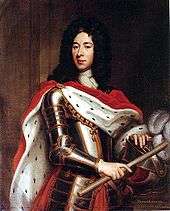Battle of Luzzara
The Battle of Luzzara took place in Lombardy on 15 August 1702 during the War of the Spanish Succession between a largely French and Savoyard army led by Louis Joseph, duc de Vendôme and an Imperial [lower-alpha 1] force under Prince Eugene of Savoy.

| Battle of Luzzara | |||||||
|---|---|---|---|---|---|---|---|
| Part of the War of the Spanish Succession | |||||||
| |||||||
| Belligerents | |||||||
|
|
| ||||||
| Commanders and leaders | |||||||
|
Prince Eugene of Savoy Prince Vaudémont |
Duc de Vendôme Philip V of Spain | ||||||
| Strength | |||||||
| 26,000[1] | 30,000–36,000 | ||||||
| Casualties and losses | |||||||
| 2,000 | 3,500 | ||||||
Prelude
Control of the Duchies of Milan and Mantua was the main strategic prize in Northern Italy as they were key to the security of Austria's southern border. In February 1701, both accepted French garrisons with Victor Amadeus II, Duke of Savoy also signing an alliance with France in April. In May, an Austrian army under Prince Eugene of Savoy [lower-alpha 2] entered Northern Italy and won a series of victories which by February 1702 had forced the French behind the Adda river.
Eugene was short of money, men and supplies and unable to take full advantage of this success while in March Vendôme took over from Villeroi and his army substantially reinforced. In June, Vendôme was joined at Cremona by the new Bourbon King of Spain Philip V; the two split their forces, with Philip besieging Imperial-held towns,[lower-alpha 3] hoping to entice Eugene away from Mantua while Vendôme tracked him looking for an opportunity to attack. After a skirmish at Santa Vittoria on 26 July, Vendôme captured Guastalla, then turning north to besiege Borgoforte. In early August, he stopped at the Austrian-held town of Luzzara on the right bank of the Po River; the total French force was around 30,000 - 35,000, including 10,000 Savoyards and five regiments of the Irish Brigade.
Eugene lifted his blockade of Mantua since these moves threatened to cut him off from his supply bases at Modena and Mirandola. Taking all available forces, around 26,000 men, he marched to intercept the French at Luzzara but arrived too late to prevent its surrender and established his headquarters at the village of Riva, north of the French positions.
The battle
Just above Luzzara, the sides of the Seraglo to Rovero canal had been built up to prevent the Po river flooding the countryside; Eugene planned to use these to conceal his movements and attack the French as they entered their camp.[2] He split his forces into two lines, the left wing under General Visconti, the right under Vaudémont and himself in charge of the centre.

During the morning and early afternoon of 15 August, the Imperialists crossed the Po and managed to achieve a large measure of surprise in surrounding the French camp but were discovered shortly before completing this.[3] Around 5:00 pm, Prince Eugene ordered a general assault; the French were taken by surprise, some units marching into the camp and immediately out again to the front line but quickly recovered. Eugene's right wing was repulsed no less than four times, while the struggle on the left was equally bloody, his Danish mercenaries nearly breaking through on several occasions. The French line managed to hold until sheer exhaustion and darkness ended the fighting round midnight.[4]
Casualties on both sides were heavy, particularly among the Irish units and Albemarle's Regiment on the right.[5] During the night, Eugene entrenched his position and the French did not resume the attack in the morning.
The overall result was a draw, although in the practice of the times Eugene claimed it as a victory, since he remained in possession of the ground. However, his forces were too weak to intervene as the French continued to take strongpoints ; the two armies lay facing each other until early November, when both went into winter quarters.
Aftermath
Eugene was recalled to Vienna in January 1703 to take over as head of the Imperial War Council, while Vendôme continued preparations for the summer campaign. In October 1703, Victor Amadeus II, Duke of Savoy defected to the Alliance and Vendôme spent the next three years in Savoy.
In 1708 Prince Eugene commissioned a series of paintings recording his victories from Dutch artist Jan van Huchtenburg, one being Luzzara which gives an indication of how he viewed it.[6]
Footnotes
- 'Imperial' refers to the Holy Roman Empire, of which Austria was a part but the terms are often used interchangeably.
- His title was unconnected to the Duchy of Savoy.
- Always conscious of the importance of prestige, his grandfather Louis XIV was anxious for Philip to win some easy victories.
References
- "Archived copy" (PDF). Archived from the original (PDF) on 12 October 2016. Retrieved 7 March 2016.CS1 maint: archived copy as title (link)
- Belsham, William (1836). History of Great Britain, From the Revolution, 1688, to the Conclusion of the Treaty of Amiens, 1802 (2017 ed.). Forgotten Books. pp. 167–168. ISBN 133076840X.
- Belsham, William (1836). History of Great Britain, From the Revolution, 1688, to the Conclusion of the Treaty of Amiens, 1802 (2017 ed.). Forgotten Books. pp. 167–168. ISBN 133076840X.
- Bancks, John (1745). The history of Francis-Eugene Prince of Savoy (2010 ed.). Gale ECCO. pp. 58–64. ISBN 1170621236.
- MacSweeney, Marquis of (June 1930). "The Casualty List of the Infantry Regiment of Albemarle at the Battle of Luzzara, 15th August, 1702". The Journal of the Royal Society of Antiquaries of Ireland. 20 (1): 84–90. JSTOR 25513547.
- "The Battle of Luzzara, 1702". The Royal Collection. Retrieved 19 April 2018.
External links
- commemorative site of 2002
- Map of the Battlefield (Red = Austrians , Blue = French)
- "The Vinkhuijzen collection of military uniforms: France, 1750-1757". New York Public Library. 25 March 2011 [2004]. Archived from the original on 6 April 2015.